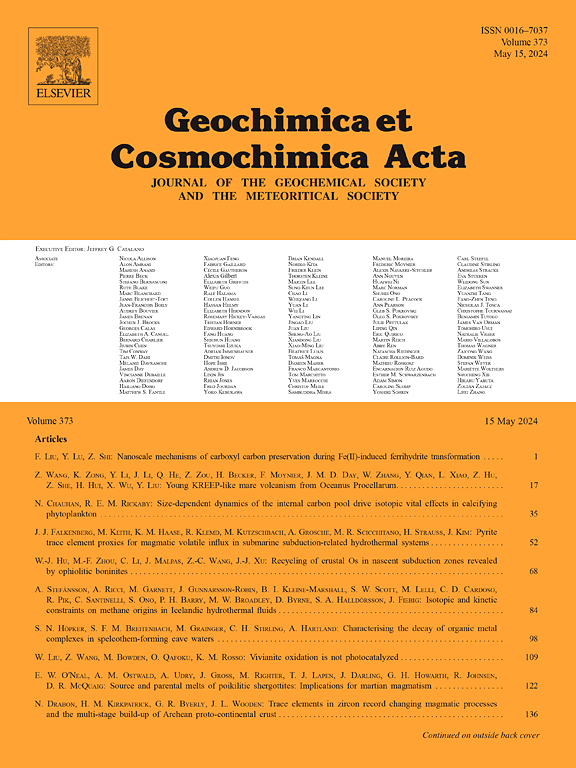Kinetics of hydrogen isotope exchange in kaolinite and the prediction of δD signature retention over geological time
IF 4.5
1区 地球科学
Q1 GEOCHEMISTRY & GEOPHYSICS
引用次数: 0
Abstract
Retention of the pristine hydrogen isotope composition (expressed as δD) formed during mineral formation in equilibrium with water is the basis for any paleoenvironmental reconstructions and for tracing mineral reactions using hydrogen (or H and O) isotope composition in kaolinite. Not only do post-formation reactions cause partial equilibration with ambient water, altering the pristine signature, but also result in the decoupling of H and O diffusion.
In this study, kaolinite samples of different structural order (expressed, for example, as the Hinckley Index) were tested for their susceptibility to H isotope exchange under D2O vapor in an open system. The H isotope exchange was detected by recording the kaolinite’s structural OH and OD stretching mode using infrared spectroscopy. A number of different in-situ and ex-situ testing protocols under diverse temperature ranges (90 °C, 125–275 °C, 300–700 °C), show consistent kinetics and mechanism. In each kaolinite sample, the H isotope exchange rate increases with temperature; however, the major control on the reaction rate is the kaolinite crystallite’s structural order, not the particle (agglomerated crystallites) size. The hydrogen isotope composition in kaolinite can be altered independently of oxygen atoms, likely via proton hopping mechanism through structural defects. The H isotope exchange reaction under vapour shows a two-mode kinetics: the time-to-the-quarter (TTTQ; t1/4) dependence dominates in the first part of the reaction or in low-temperature reactions, transitioning to the log10t (Elovich) relationship and with lower activation energy, in advanced stages and in higher temperatures. Extrapolating the TTTQ model to temperatures < 90 °C allows estimating the rate of H isotope exchange between water vapor and kaolinite. The paper presents the prediction of preservation of pristine δD signature and thus reliability of using isotope data in kaolinites of different origins and structural order when exposed to pore water / water vapor over geological timescales.
求助全文
约1分钟内获得全文
求助全文
来源期刊

Geochimica et Cosmochimica Acta
地学-地球化学与地球物理
CiteScore
9.60
自引率
14.00%
发文量
437
审稿时长
6 months
期刊介绍:
Geochimica et Cosmochimica Acta publishes research papers in a wide range of subjects in terrestrial geochemistry, meteoritics, and planetary geochemistry. The scope of the journal includes:
1). Physical chemistry of gases, aqueous solutions, glasses, and crystalline solids
2). Igneous and metamorphic petrology
3). Chemical processes in the atmosphere, hydrosphere, biosphere, and lithosphere of the Earth
4). Organic geochemistry
5). Isotope geochemistry
6). Meteoritics and meteorite impacts
7). Lunar science; and
8). Planetary geochemistry.
 求助内容:
求助内容: 应助结果提醒方式:
应助结果提醒方式:


